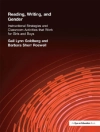The storied landscapes of Ireland are dotted with holy wells—hallowed springs, pools, ponds, and lakes credited with curative powers and often associated with Catholic and indigenous saints. While many of these sites have been recently lost to development, others are visited daily for devotions and remain the focus of annual community gatherings.
Encouraging both their use and protection, Holy Wells of Ireland delves into these irreplaceable resources of spiritual, archaeological, and historical significance. Reserves of localized spiritual practices, holy wells are also ecosystems in themselves and provide habitats for rare and culturally meaningful flora and fauna. The shift toward a ‘post-Catholic’ Ireland has prompted renewed interest in holy wells as popular domains with organic faith traditions. Of the roughly 3, 000 holy wells documented across Ireland, some attract international pilgrims and others are stewarded by a single family. Featuring 140 color images, this remarkable volume shares the transdisciplinary work of contributors who study these wells through the overlapping lenses of anthropology, archaeology, art history, biomedicine, folklore, geography, history, and hydrology. Braiding community perspectives with those of scholars across academia, Holy Wells of Ireland considers Irish holy wells as a resilient feature of ever-evolving Irish Christianity, as inspiration to other faith traditions, as places of pilgrimage and healing, and as threatened biocultural resources.
विषयसूची
An Introduction to the Holy Wells of Ireland, by Celeste Ray
Part 1: Natural Features of Holy Well Landscapes
1. Sacred Stones by Healing Wells, by Celeste Ray
2. Cranfield Stones at St. Olcan’s Well, County Antrim, by Patrick Mc Ateer and Celeste Ray
3. Healing Soils and Holy Wells of County Fermanagh, by Gerry A. Quinn
4. The Plants and Animals Associated with Holy Wells in Irish Folk Tradition, by Niall Mac Coitir
5. The Submerged Well of Many Names, Lacken, County Wicklow, by Geraldine Lynch
6. The Water Sources and Chemistry of Irish Holy Wells, by Bruce Misstear, Laurence Gill, Cora Mc Kenna, and Ronan Foley
Part 2: Holy Wells in Irish Christianity
7. The Conversion Function of Holy Wells in the Tripartite Life of Patrick, by Claire Collins
8. Holy Wells of County Clare, by Michael Houlihan and Maura Egan
9. Holy Wells, Saintly Authority, and the Fountain of Life in Early Irish Hagiography, by Shane Lordan
10. Tobar Chuáin agus Brocáin at Mothel, County Waterford, by Eugene Broderick
11. Saint Colmcille’s Well, Doonierin, County Sligo, by Tamlyn Mc Hugh
12. St. Mochua’s Well, Derrynoose, County Armagh, by John Makem
13. Curative Waters and Penance: The Many Traditions of Irish Holy Wells, by Finbar Mc Cormick
14. Tobar Phádraig, Monivea, County Galway, by Christy Cunniffe
15. Two County Fermanagh Wells, by Janet Cassidy and Fred Ternan
Part 3: The Cure
16. Holy Wells and ‘The Cure’ in Twentieth-Century Ireland, by Carol Barron
17. Father Moore’s Well, County Kildare, by Suzanne Pegley
18. The Holy Wells of County Cork, by Amanda Clarke
19. Holy Wells of North Leinster: A Medical Geography, by Ronan Foley
20. St. Brigid’s Well, Liscannor, County Clare, by Rita Mc Carthy
Part 4: Pilgrimage and Patterns
21. Tents, Ale-Poles, and Pattern Pies: An Examination of the Temporary Shelters and Food of the Pattern Day 1700–1950, by Shane Lehane
22. Mám Éan, by Michael Gibbons and Anja Renkes
23. Rock, Bell, Steeple: Revisiting the Ardmore Pattern, County Waterford, by Stiofán Ó Cadhla
24. St. Fiachra’s Well at Ullard, County Kilkenny, by Edward N. Moran
25. St. Patrick’s Well at Holywell, County Fermanagh, by Janet Cassidy
Part 5: Irish Identities and Evolving Devotions
26. Shaping Ireland: The Holy Well in Irish Painting, by Anne Cormican
27. Mo Griffith: A Water Liberator, by Celeste Ray, Annie Griffith, and Hannah Chew
28. Irish Travellers and Holy Wells, by Attracta Brownlee
29. Devotional Heritage on Inishark and Inishbofin, by Ryan Lash
30. The Holy Wells of County Dublin, by Gary Branigan
31. Cillíní (Children’s Burial Grounds) and Holy Wells in Early Modern Ireland, by Colm Donnelly and Eileen Murphy
32. The Ecumenical Re-Opening of St. John the Baptist’s Holy Well in Drumcondra, County Dublin, by Bernadette Masterson
33. Layered Resonance at Abbeyswell, County Cork, by Ray Cashman
34. The Destruction of St. John’s Well at Warrenstown, County Meath, by Noel French
35. Afterword, by Celeste Ray and Finbar Mc Cormick
Index
लेखक के बारे में
Celeste Ray is Professor and Chair of Anthropology and Director of the Environmental Arts and Humanities Program at Sewanee: The University of the South. She is author of The Origins of Ireland’s Holy Wells and of Highland Heritage: Scottish Americans in the American South. She is editor most recently of Sacred Waters: A Cross-Cultural Compendium of Hallowed Springs and Holy Wells. Finbar Mc Cormick is a retired Senior Lecturer from the School of Natural and Built Environment at Queen’s University Belfast. He is author (with Aidan O’Sullivan, Thomas R. Kerr, and Lorcan Harney) of Early Medieval Ireland, AD 400–1100: The Evidence from Archaeological Excavations and (with Emily Murray) of Knowth and the Zooarchaeology of Early Christian Ireland.












